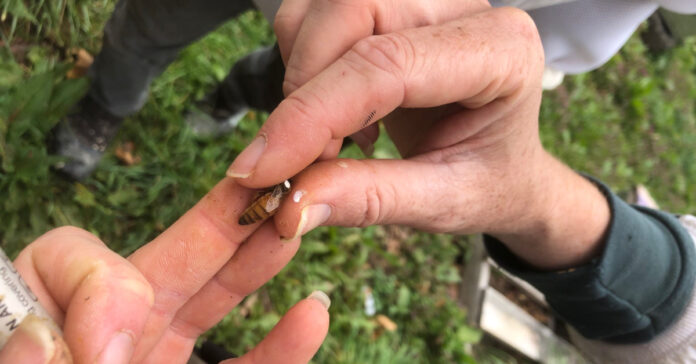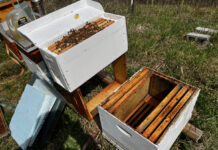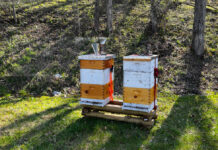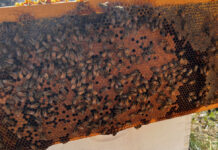
I spent a few hours at a local commercial beekeeper’s bee yard Wednesday helping out. Depending on the time of year, they have at least 100 hives and sell nucleus hives (nucs) and queens as well as honey and honey products. Volunteering there gives me valuable experience and has made me a better beekeeper. It also gives me an inside track when I have questions or need advice.
The hot-cold-warm-freezing weather cycle this spring has been tough on their bees and has made queen rearing difficult. One of my jobs today was to open breeding hives and look for queens. This is a two-frame hive in which they placed a queen cup in several weeks ago. The queen hatches and then a few days later, goes on her mating flight. After another week, she should start laying eggs.
One of my jobs was to pull the frames up and look for any sign of a queen. This could mean eggs or uncapped brood in the comb (it is too soon for capped brood). It might also mean we spotted the queen, in which case we caught and marked her with a white dot as seen in the photo above. Only about half the breeding hives had any sign of queens, meaning the queens likely died on their breeding flight or got lost and never made it back to the hive.
By the way, if you have never had the opportunity to search on a frame of 1,000 bees trying to find a queen, you will have to take my word that it can be a difficult task. Picture a writhing mass of bees and you have to find the one with a bigger abdomen. Some of the queens are quite good at hide and seek.
Lost or Missing Queen Bees
A few days after being born, a virgin queen will go on her mating flights. Sometimes, they do not return. This might mean a bird or another predator ate them. Bad weather can also cause the death of a queen or blow her off course. My guess is that this is what happened to most of these missing queens.
So now they have to go through those hives and put new queen cups in and hope the next queen has more luck and makes it back to the hive alive.
The breeding hives that had queens will form nucleus hives for sale. The nuc seller transfer the two frames from the queen rearing hive into a four or five-frame bee hive (or nuc box) and adds another frame of brood from a large, productive hive, plus a frame or two of nectar and pollen.
In my experience, it is better to start your hive with a nuc, not a package. Nucs give you a bred queen that is already laying, up to three frames of brood in different stages, and some food to keep them going. This allows your hive to grow and expand right away. This, of course, is what you want because a bigger, more robust hive should produce more honey.
In contrast, if you buy a package of bees, you get bees and a bred queen, but no brood or food. When you put them in a hive, your bees are hungry, so you have to feed them. Then they have to draw out the comb before the queen can lay. Then it takes three weeks before the first new bee is born. In my estimation, a hive started from a package is four weeks behind a hive started from a nuc in growth.
One difference between the two is cost. Around here, a nuc with large frames costs more than $200, while a package is around $150.
I’m Getting Queen Cups for my Splits
I made arrangements to go back next week and pick up two queen cups from which a queen will emerge in a day or two. My plan is to make two small splits from the one large hive I mentioned earlier this week and add one queen cup to each. Then I will have to wait the two weeks or more to see if my queens hatch, get mated, return, and start laying eggs. If all goes well, I should have two new, productive hives by mid-May, just in time for the spring honey flow to kick off. If all doesn’t go well, I will hope that I lose only one. In that case, I will combine the two small splits into one with the surviving queen.
I just have to hope we don’t have more cold, windy weather while my queens are on their mating flights.






